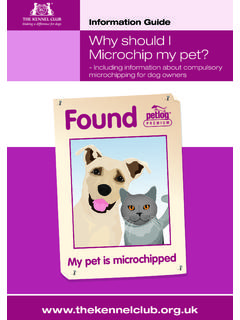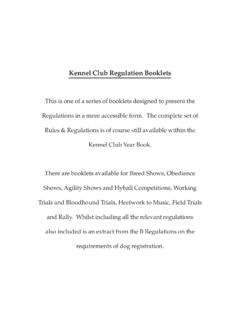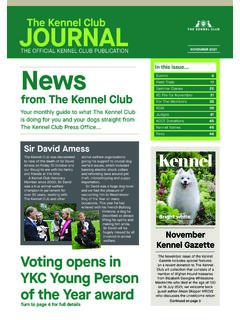Transcription of THE KENNEL CLUB GOOD CITIZEN DOG SCHEME – GOLD …
1 THE KENNEL CLUB GOOD CITIZEN . DOG SCHEME GOLD AWARD. DESCRIPTION OF EXERCISES. AIM. The KENNEL Club Good CITIZEN Dog SCHEME Gold Award is the highest level of achievement of the SCHEME . It builds upon the skills learnt in the Silver Award and develops more advance training skills of the dog and handler. The Gold Award is a natural progression of practical dog training skills and introduces new concepts such as relaxed isolation, stop the dog and send the dog to bed exercises, which are important in every day life situations. The Gold Award aims to provide handlers with a greater knowledge and understanding of their canine companion. Dogs that are awarded a Gold Certificate should reach the required standards in all exercises and be a worthy representative of the SCHEME 's highest standard. Where possible it is preferable that certain exercises are tested at indoor and outdoor locations. ELIGIBILITY.
2 The SCHEME is aimed at all dogs whether KENNEL Club registered or not. Dogs must be a minimum of 12 months old to be eligible to take part in a Gold Award Test. For the Gold Test, Examiners will only accept dogs that have been awarded a Silver Award Certificate. Handlers must show that they have means of cleaning up after their dog and that it has proper identification which is legally compliant. With effect from the 6th April 2016 dogs are required to have a microchip which is registered on a Defra-approved database, in the UK (check exemptions). Examiners are required to check each dog's eligibility and the suitability of their collar, lead and equipment prior to the test commencing. STANDARD REQUIRED. The test is non-competitive but Examiners should be satisfied that dogs are worthy of passing. Examiners should also observe the spirit of the SCHEME , which is to produce happy, contented dogs, which are well behaved, and under the control of handlers who fully understand the responsibilities to their dogs, to their neighbours and to the community.
3 Handlers are permitted only one attempt at each exercise under test, unless there are exceptional circumstances or where a dog has been clearly disadvantaged or interfered with. Examiners should be aware that they should give clear instructions to the handlers as to how they would like the exercise conducted in order to avoid confusion. A Certificate will be awarded when the required standard has been achieved. Any uncontrolled mouthing, barking, growling or other threatening behaviour is not acceptable and further training will be required before the dog can be passed. In order that it be meaningful the testing must be carried out rigorously. Emphasis must be placed upon the ability of the handler to handle, care for and generally be responsible for their dog. Examiners can reserve the right to insist that the handler secures the dog in a safer manner if the equipment used is deemed inadequate.
4 An additional lead could be used in this instance. THE TEST. Dogs may be tested singly or in groups, those passing all parts of the test will receive a Good CITIZEN Dog SCHEME Gold Award Certificate. The Examiner will enter the comment Passed or Not Ready along side each exercise. In order to receive a Certificate, dogs must receive the comment Passed for each exercise during one testing session. The Club/Organisation arranging the test will be responsible for appointing an Examiner and the standards required are stated in the SCHEME 's Guidelines and Information Handbook and should be strictly adhered to. HANDOUTS. Literature to be given out at the beginning of each training course:- Gold Award Description of Exercises Canine Code (including Responsibility and Care). DESCRIPTION OF EXERCISES. Exercise 1 - Road Walk The object of this exercise is to test the ability of the dog to walk on a lead under control on a public highway beside the handler and for the handler to determine the speed of the walk.
5 This exercise should be carried out at a suitable outdoor location and an occasional tight lead is acceptable. The handler and dog should walk along a pavement, execute a turn, then stop at the kerb where the dog should remain steady and controlled. On command they should proceed, observing the Highway Code. When reaching the other side they should turn and continue walking, making a few changes of pace from normal to slow or fast walking pace. The handler and dog will return across the road to the starting point of the exercise. Distractions should be incorporated such as passing vehicles or bicycles, people, wheelchairs, prams, pushchairs, etc. Note: The turns are only tests of ability to change direction. Exercise 2 - Return to Handler's Side The object of this exercise is to be able to bring the dog back under close control during a lead free walk. With the dog off lead and not less than 10 paces away, upon instruction, the dog will be called back to the walking handler's side and both should continue together for approximately ten paces.
6 Note: A dog moving loosely at the handler's side, under control, is quite acceptable and there is no requirement for a halt to complete the exercise. Exercise 3 - Walk Free Beside Handler The object of this exercise is for the dog to be kept close to the handler's side as may be necessary on a walk in the park. This is a test of control whilst walking with a dog off lead beside its handler for approximately 40 paces. Competition heelwork is not the aim, but is acceptable. Therefore, it is only necessary for the dog to be kept loosely beside the handler. Two changes of direction will take place A4 Gold Award MS2 1 04/03/2016 11:23. THE KENNEL CLUB GOOD CITIZEN . DOG SCHEME GOLD AWARD. and there will be the distraction of another handler passing with a dog on a lead. Upon instruction the handler will attach the lead to finish to the test. Note: Changes of direction are right and left turns without formality.
7 Exercise 4 - Stay Down in one Place The object of this exercise is that the dog will stay down on the spot while the handler moves away for two minutes both in and out of sight. This stay will be tested off lead and handlers should place their dogs in the down position. During the test the handler will be asked to move out of sight for approximately half a minute. While in sight handlers will be approximately ten paces away from their dog. The test is completed when the handler returns to the dog's side. Note: This exercise is a test to see if the dog will stay down in one place without changing position. Exercise 5 - Send the Dog to Bed The object of this exercise is to demonstrate control such as might be required in the home. The handler may provide the dog's bed, blanket, mat, or an article of clothing, etc. The handler should place the dog's bed in a position determined by the Examiner. The handler will stand approximately ten paces from the bed.
8 Upon instruction, the handler will send the dog to bed where the dog will remain until the Examiner is satisfied the dog is settled. Note: The dog is not being sent to bed in disgrace. Where possible this exercise should be tested indoors. The bed used should be suitable for the dog under test and no inducement toys or food should be used during this exercise. Exercise 6 - Stop the Dog The object of this exercise is for the handler to stop the dog at a distance in an emergency situation. With the dog off lead and at a distance, not less than approximately ten paces away, the handler will be instructed to stop the dog on the spot in any position. Note: The dog should be moving and is expected to respond straight away to the stop command, but if moving at speed, will be allowed a reasonable distance to come to a stop. Exercise 7 - Relaxed Isolation The object of this exercise is for the dog to be content when left in isolation.
9 During such times the dog should not become agitated, unduly stressed or defensive. The handler should fasten the dog to an approximate two metre line and then move out of sight for between two five minutes as directed. Alternatively, the dog may be left in a room on its own, or left in a room on its own in a suitable crate/cage, provided undetected observation can take place. The owner must provide the crate/cage if one is used. Examiners should choose appropriate venues when conducting this exercise. Handlers can choose the method of isolation, however the Examiner will determine the testing area to be used. This must be a safe area but not to include a vehicle. Any number of dogs may be tested at the same time provided they are isolated at different locations. It is acceptable for the dog to move around during isolation, however should the dog whine, howl, bark, or indulge in any disruptive activities it should not pass this exercise.
10 Note: Dogs should be tested for their relaxed demeanour in isolation without any prior controls being imposed by the handler. This is not a stay exercise but handlers may settle their dogs before leaving. This is a practical test and no inducement blankets, toys or food should be used during this exercise. Examiners can reserve the right to insist that the handler secures the dog in a safer manner if the equipment used is deemed inadequate. Exercise 8 - Food Manners The object of this exercise is for the dog to be fed in an orderly manner. The handler will offer food to the dog either by hand or in a bowl. The dog must wait for permission to eat. After a three - five second pause, the handler will be asked to give the dog a command to eat. Note: The dog should not eat until given permission, however if attempting to do so, it is acceptable for the handler to restrain the dog by voice alone. Exercise 9 - Examination of the Dog The object of this exercise is to demonstrate that the dog will allow inspection of its body by a stranger as might be undertaken by a veterinary surgeon.













